Introduction
Baseball has been described many ways by many people, but bizarre and g**damn frustrating has to be at the top of everybody’s list.
On a sunny, late-summer Monday afternoon on the North Side, Jon Lester outdueled reigning American Cy Young winner Corey Kluber of the Cleveland Indians in his most efficient start as a Cub. And yet, his personal result, a no-decision, was no different than his second start of the season, when he surrendered six earned runs on 10 hits against Cincinnati Reds. This is the result of, yes, a bizarre and g**damn frustrating ninth inning for Lester, but it should not overshadow one of his five best starts of the season.
It was Lester’s longest outing as a Cub, and the first time he’s pitched into the ninth inning since last August 7th against the Minnesota Twins, a span of 34 starts. Lester needed nine or fewer pitches in three different innings, including just four pitches in the third. He did not have a 20-pitch inning for just his second start all season. Lester induced 11 whiffs a start after getting a season-low five against the Tigers.
Lester was tremendously effective on first pitches, picking up 11 called strikes and six outs on balls in play, both season highs:
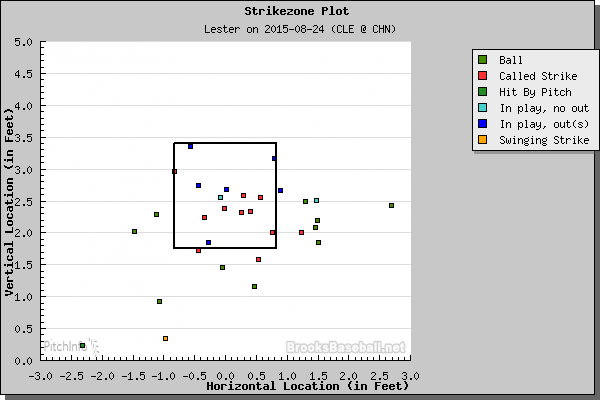
The high called strike total is not surprising, as Cleveland entered the game with the third-lowest swing percentage in the AL. If you continue reading (please) to the Pitch Breakdown section below, you will see just how prolific and effective Lester’s four-seam fastball was to start at-bats. Lester also had his most effective sinker of the season.
In 2015, the Cleveland Indians have been devoid of power, ranking bottom three in the AL in home runs, slugging percentage, ISO, and home run to fly ball ratio. The team’s home run leader (Brandon Moss) has not been on the roster in almost exactly a calendar month. Of the team’s 10 players with at least 250 plate appearances, six have an OPS of .695 or worse. Against left-handed pitchers, the team has the second-worst ISO in the AL. The team does excel at getting on base, ranking in the top three in the AL in walk rate and on-base percentage, and top five in both against left-handed pitchers.
On Monday, though, Cleveland struggled to both put runners on base (nine) and hit for power (zero extra-base hits). The end of Lester’s day was disappointing, but it was preceded by 8 2/3 innings of sharp and economical baseball. It was a masterful rebound performance, to put it understatedly, so read below to learn how Lester got back on track.
Traditional Line
8.2 IP, 6 H, 6 K, 1 BB, 0 ER
Pitch Breakdown
97 pitches (62 strikes)
| Total | Velocity (Max) | AVG | SLG | BABIP | |
| Four-Seam | 39 | 93.2 (94.7) | .143 | .143 | .167 |
| Cutter | 24 | 88.6 (89.9) | .200 | .200 | .333 |
| Sinker | 11 | 92.0 (93.6) | .000 | .000 | .000 |
| Change-Up | 5 | 85.9 (86.9) | .333 | .333 | .500 |
| Curveball | 18 | 76.3 (79.3) | 1.000 | 1.000 | 1.000 |
Lester’s pitch selection against Cleveland was uniquely not unique, as all five of his pitches were thrown within three percent of his season average entering the game.
Lester used his four-seam fastball to get ahead of Cleveland hitters, throwing it first pitch to 22 of 31 batters. Of the 22, 15 went for first-pitch strikes or outs. Lester continues to stray from his four-seam fastball with two strikes, using it to pick up just one of his six strikeouts. Through the end of July, Lester had gone to his four-seamer in two-strike counts 40 percent of the time against left-handed hitters and 39 percent of the time against right-handed hitters. Four-seamers accounted for 37.4 percent of his strikeouts. In four August starts, four-seam two-strike usage has dropped to 16 percent against left-handed hitters and 22 percent against right-handed hitters. During the month, four-seamers have accounted for just 13 percent of strikeouts. It has become a Trend (hey, that’s the title of his next section!), but not yet a concern.
Though he threw just 11, the story of this game, for (mostly) better and (slightly) worse, was his SINKER. As we mentioned in the Introduction section, he might have had his most effective sinker of the season. Lester induced all three double plays with his hard sinker. He went to it with 11.3 percent frequency—right at his season average—and threw eight of 11 for strikes, without surrendering a base runner off the pitch, and using it to neutralize any rallies.
Lester picked up another four strikeouts with his cutter, and 11 of 23 strikeouts in August have come with the pitch (see Trends section). Against Cleveland, he used his cutter to induce five whiffs on just 14 swings. In four starts this month, opposing batters are slugging just .303 against Lester’s cutter, after slugging .432 through July.
Trends
We will keep this Trends section brief, as we delve deep in the Key At-Bat/Sequence section below.
Last week, and above in the Pitch Breakdown section, we chronicled how Lester’s four-seam fastball has been sparse late in counts. While this is curious, it shouldn’t be overlooked that his cutter has emerged as a go-to strikeout pitch. The frequency of cutters has not increased in August, but the percentage of strikeouts from the cutter have increased significantly:
| Month | Avg. Cutter Velocity | Frequency of Cutter | Percentage of Strikeouts |
| April | 88.06 MPH | 27.86% | 30.4% |
| May | 89.41 MPH | 27.35% | 27.0% |
| June | 89.64 MPH | 24.52% | 33.3% |
| July | 88.71 MPH | 28.91% | 30.0% |
| August | 88.55 MPH | 25.69% | 47.8% |
Not surprisingly, as you can see below, Lester’s cutter usage with two strikes has increased dramatically in August:
| Month | vs. LHH | vs. RHH |
| April | 43% | 33% |
| May | 68% | 26% |
| June | 47% | 23% |
| July | 35% | 26% |
| August | 60% | 42% |
When Lester’s two-strike cutter usage against left-handed batters jumped to 68 percent in May, the pitch accounted for 27 percent of his strikeouts, the lowest of any month so far. This month, though, when his two-cutter usage against right-handed batters has jumped to a season-high 42 percent, his cutter is responsible for 48 percent of strikeouts. This is not shocking, as right-handed batters account for 77 percent of plate appearances against Lester in 2015.
With two strikes on hitters, Lester is straying from his four-seamer in favor of his cutter and curve.
Key At-Bat/Sequence
Inning: Ninth
Score: 1-0, Cubs leading
Situation: Two outs, Francisco Lindor on first base, Abraham Almonte on second base
Batter(s): Carlos Santana
If a history between a pitcher and batter can be developed in one game , then Carlos Santana was the batter Lester wanted at the plate one out away from a complete game shutout. While Lester and Santana did have some previous history—Santana entered 3-for-12 without an extra-base hit in 15 plate appearances—his first three at-bats against Lester were not fun for him, to say the least, and set the stage for the game’s biggest at-bat.
Entering Monday, Santana had struggled against left-handed pitchers this season, hitting .243/.351/.306 with just seven extra-base hits. Even more so, he had been unable to do much against sinkers from left-handed pitchers, slugging .200 without an extra-base hit. As you can see below, in 2015, when Santana has puts balls in play against sinkers from left-handers, even when the pitch is up, they have been on the ground:
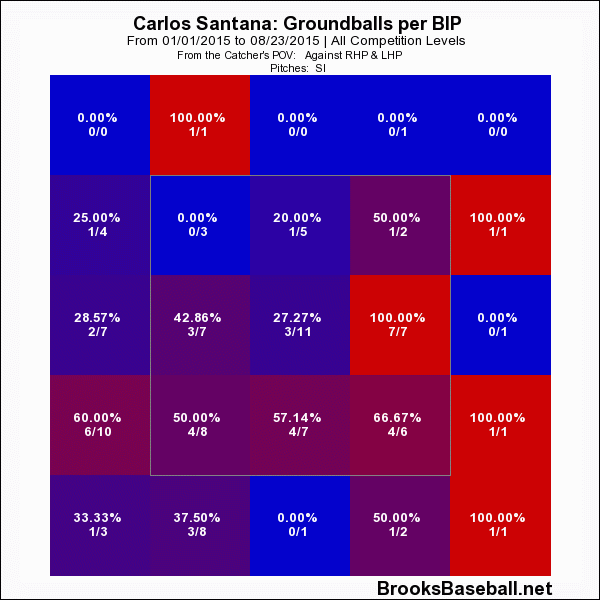
Likely knowing this, Lester and Ross seemed to have a clear, sinker-heavy gameplan against Santana for three at-bats. In Santana’s first at-bat, Lester got ahead 0-and-2 with a 92.8 mph four-seamer on the outside corner for strike one, and then came back with curve on the bottom of the zone that Santana fouled off. Lester tried to put away Santana with a 93.2 mph sinker that came too far down and in:
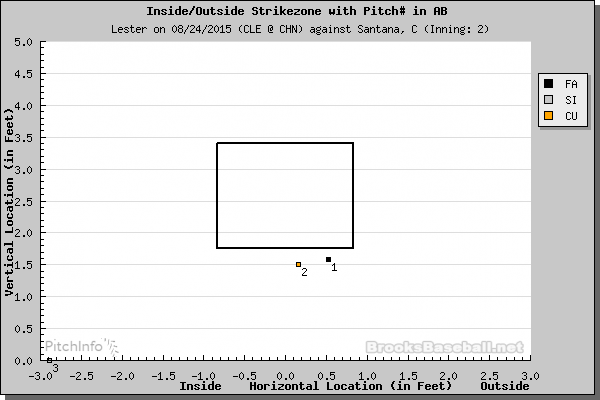
Santana was aboard via the hit by pitch, but this sequencing of pitches—four-seamer, curve, sinker—would be seen again.
In Santana’s second at-bat, Lester stayed away from Santana, falling behind 2-and-0 with a sinker and changeup off the plate. Down in the count, Lester came back with a 93.5 mph sinker in a zone that almost always results in Santana ground balls:
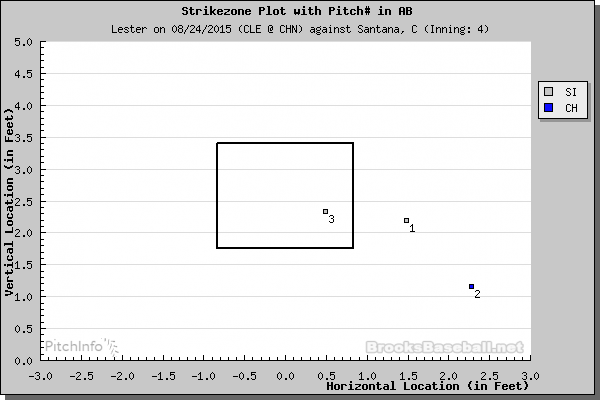
Santana obliged, hitting the ball on the ground to Starlin Castro, who began an inning-ending 6-3 double play.
In Santana’s third at-bat, Lester again stayed off the plate. Behind 3-and-1, he came back with a 91 mph high sinker:
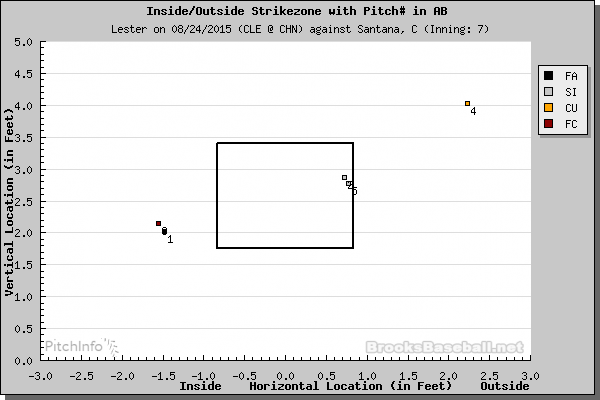
As the zone profile at the top this section demonstrated, though, Santana tends to put even high sinkers in the ground. Santana put the ball on the ground to La Stella, who began the inning-ending 4-6-3 double play.
Of the 10 pitches Lester threw to Santana in his first three at-bats, five were sinkers.
In Santana’s fourth at-bat, Lester attacked Santana with the exact same sequence as his first at-bat. Lester got ahead with a 92.8 mph four-seamer for a called first strike. Like in their second-inning matchup, Lester tried to come back with a curve:
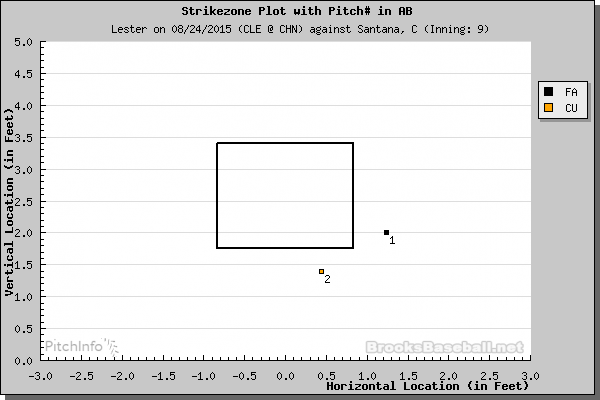
Ross set-up down and inside, but the pitch stayed over the outer edge. Santana went down to get it and lined the pitch into left field, scoring Almonte to tie the game.
It was a good piece of hitting, but was Santana anticipating the curve following the four-seamer, having remembered the first at-bat? Was Lester trying to set-up the sinker? No matter the reason, Lester’s day was over, along with his bid for a complete game shutout.
Keep In Mind
This KIM (c) section is more of an “Interesting fact you don’t see everyday” section.
Lester has never been a heavy fly-ball pitcher (28.8 percent fly-ball rate on the season, 33.4 percent for his career), but against Cleveland he had just one fly ball or pop up in play. In the second inning, Yan Gomes popped up a first pitch 93.8 mph four-seamer fastball to Tommy La Stella is shallow center field. Ross called for the pitch down in the zone, but it stayed up and in:
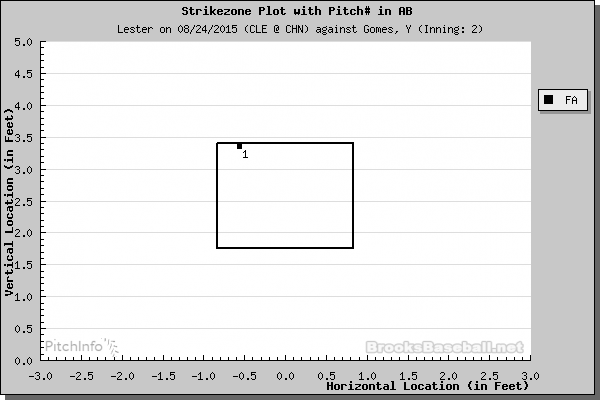
Gomes, however, was unable to do anything with the high fastball. You will not see many starts like that at Wrigley Field, especially on a day when the wind is so constant.
Conclusion
After his last week’s disastrous start against the Tigers, we concluded the following:
In the course of 32-33 starts, these nights happen. As he has this season after his miserable April and poor first half of June, I expect Lester to rebound and continue takin ‘er easy for all us sinners.
Against Cleveland, Lester rebounded and I stopped making Big Lebowski references. So, you, the loyal Cubs fan, are a winner twice over. Lester was outstanding against the Indians, using his sinker to pick up timely ground balls, getting ahead of batters with his four-seam fastball, and as a result of both, was remarkably efficient with his pitch count. As Bleacher Nation’s Brett Taylor noted after the game:
It was a great bounce back from whatever happened in that Tigers game. After the start, Lester settled back comfortably into the top 18 in FIP, xFIP, and WAR in all of baseball.
It is an excellent reminder that despite the poor outing five days earlier, Lester has been among baseball’s best starting pitchers since at least mid-June, if not early May. He did not get the win he deserved (g**damn frustratingly), but Lester (with some with help from Kris Bryant) was the biggest reason Wrigleyville was a rollicking party as the Cubs departed for the West Coast.
Season to Date
8-9, 3.44 ERA (4.16 DRA), 1.204 WHIP, 24.6% K, 6.2% BB
Next Start
Saturday, August 29 at Los Angeles Dodgers
Lead photo courtesy of Caylor Arnold-USA TODAY Sports
